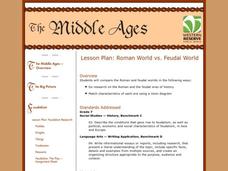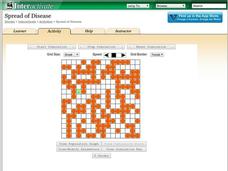Federal Reserve Bank
“W” Is for Wages, W-4 and W-2
Don't let your young adults get lost in the alphabet soup of their paychecks and federal income taxes. Using sample pay stubs and reproductions of government forms, your class members will identify the purpose of such forms as a W-4 and...
Curated OER
Diversity Government
Students explore diversity through government. In this diversity lesson, students use types of government as a way to understand the importance of diversity. Students use "diversity beans" to facilitate discussion with one another.
Curated OER
Limited v. Unlimited Government
Students compare and contrast the characteristics of a limited and unlimited government. In groups, they use this information to create a chart and write a description of how leaders are chosen in each. They share their information...
Curated OER
To Be or Not to Be Democratic
Seventh graders explore the democratic republic principles of U.S. government. In this U.S. government lesson, 7th graders compare and contrast the governments of ancient Athens,the Roman Republic, and the United States today. Students...
Curated OER
Comparing World Religions
Sixth graders participate in a lesson of comparing the religions of the world. They conduct research using the essential questions provided in the lesson. There is a rubric for the writing assignment for assessment.
Curated OER
Comparing Democracy and Republic
Learnerscomplete a graphic organizer comparing the republic of Rome and the democracy of Athens and realize that these two governments influenced US government.
Curated OER
Comparison of Economic Systems
Here is a worksheet in which learners identify and compare economic systems (market, command, mixed, etc.) with 18 fill-in-the-blank questions and a graphic organizer.
San Antonio Independent School District
Colonies in the Americas
Compare and contrast the goals, types of government, interactions with Native Americans, and other important features of the Spanish, British, and French colonies in the Americas with this graphic organizer.
Northeastern Educational Television of Ohio, Inc.
Roman World vs. Feudal World
Young historians compare the major features of the Roman and feudal worlds, such as religion, social hierarchy, and political tenets, using online resources and group discussion.
Curated OER
Finding Meaning in the Badge
Children who are three to five years old study two rank badges from the Qing dynasty to develop an understanding of social rank, language skills, and symbolism. The lesson is discussion-based and requires learners to compare and contrast...
Shodor Education Foundation
Spread of Disease
Control the spread of a contagious disease. An applet allows pupils to run a simulation on the spread of a disease. Rules govern how the disease is spread and the length of time it takes to recover. Learners view the spread visually and...
US Institute of Peace
Mediating Conflict
Two's a negotiation, but three's a mediation! Demonstrate the differences between the two processes through a role-playing lesson plan. The activity familiarizes pupils with the role of a mediator and examines the types of situations...
Tutorials Point India Private
E-Commerce Tutorial
How does electronic commerce benefit organizations, customers, and society? Scholars read about e-commerce as it applies to modern business practices in an informative tutorial. Pupils also discover different types of business models in...
Curated OER
Government Lesson Plans
Students can learn how their government is organized through these engaging lesson plans.
Curated OER
Government Lesson Plan 16
High schoolers identify different economic systems, compare economic systems by determining how the three basic economic questions are answered in each, and explain concept of mixed economies.
Curated OER
Judicial Branch & Supreme Court Questions
In this U. S. government worksheet, students respond to 19 short answer questions about the responsibilities of Supreme Court members in the United States.
Curated OER
Montana Reservation Governments
Third graders examine the types of governments on Indian reservations. In groups, they research the responsibilities of local and tribal governments. As a class, they discuss how the state of Montana meets the needs of its citizens...
Curated OER
A Proper Role for Government - Seeking Perfection in an Imperfect World
Students discuss the proper role of government in the economy. Reviewing the foundations for a market economy to work properly, they decide how to best direct resources to get the most out of them. They distinguish between private and...
School Improvement in Maryland
Political Systems: Advantages and Disadvantages
Every political system has advantages and disadvantages. To gain an understanding of these differences, groups investigate the political system of another country—oligarchy, monarchy, dictatorship, parliamentary—and prepare a...
School Improvement in Maryland
Court Proceedings Civil Cases
What's the difference between civil and criminal law? How do the court proceedings differ in these two types of trials? How do the standards of proof differ? Why do these differences exist? As part of their examination of the US court...
Stanford University
Great Society
Students explore the Great Society. In this U.S. history and government instructional activity, students view the video "The Great Society," identify the major points of the speech, and compare and contrast the content with The New Deal.
Curated OER
Magnets in a Bag
Fifth graders compare and contrast the patterns that they create using iron fillings and different types of magnets.
Curated OER
Greek Governments Comparison
In this World History activity, students compare and contrast five different Greek Government systems in a chart. They identify who ruled each type of government. In addition to, students list the characteristics and weaknesses of each...
Curated OER
Closing the Salary Gap
Students explore careers in their community and compare the average salaries for men and women working in those careers. They explore a variety of careers available in their community through participating in this lesson plan.

























